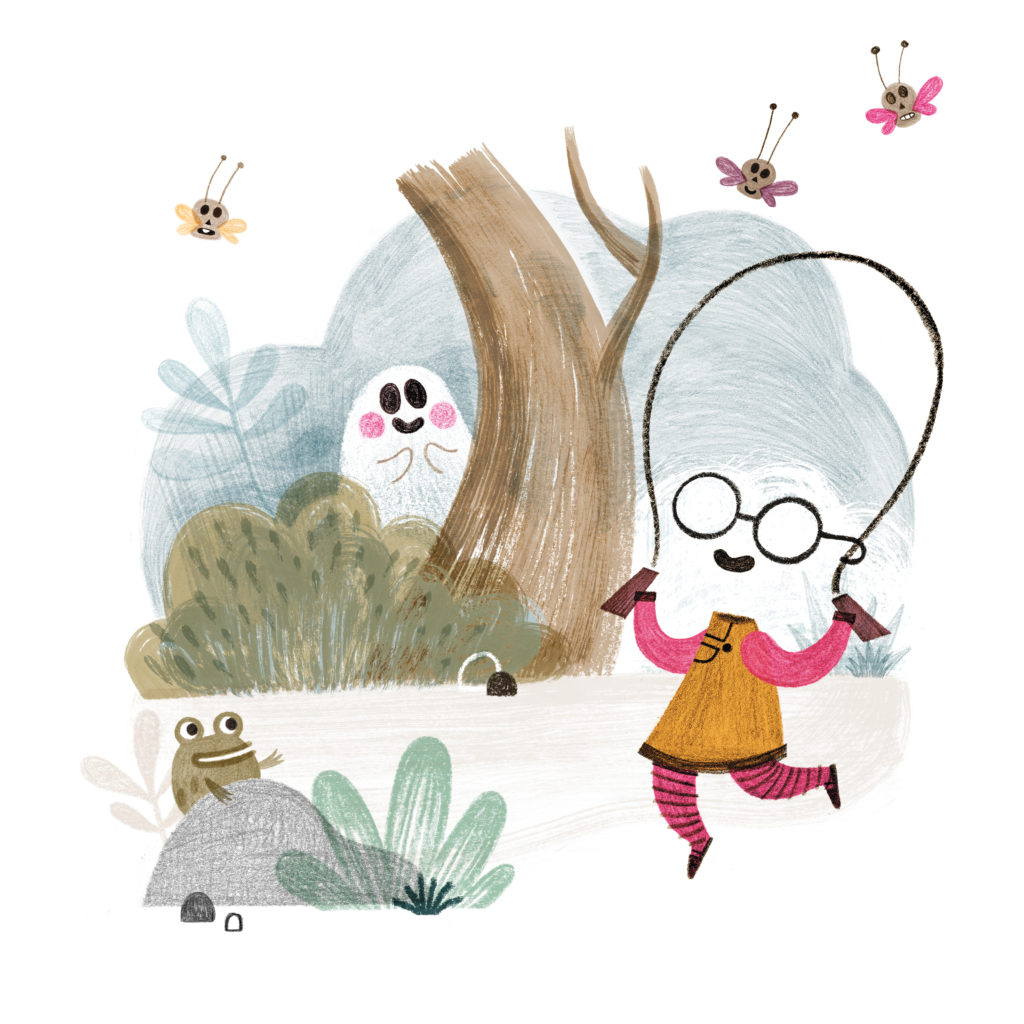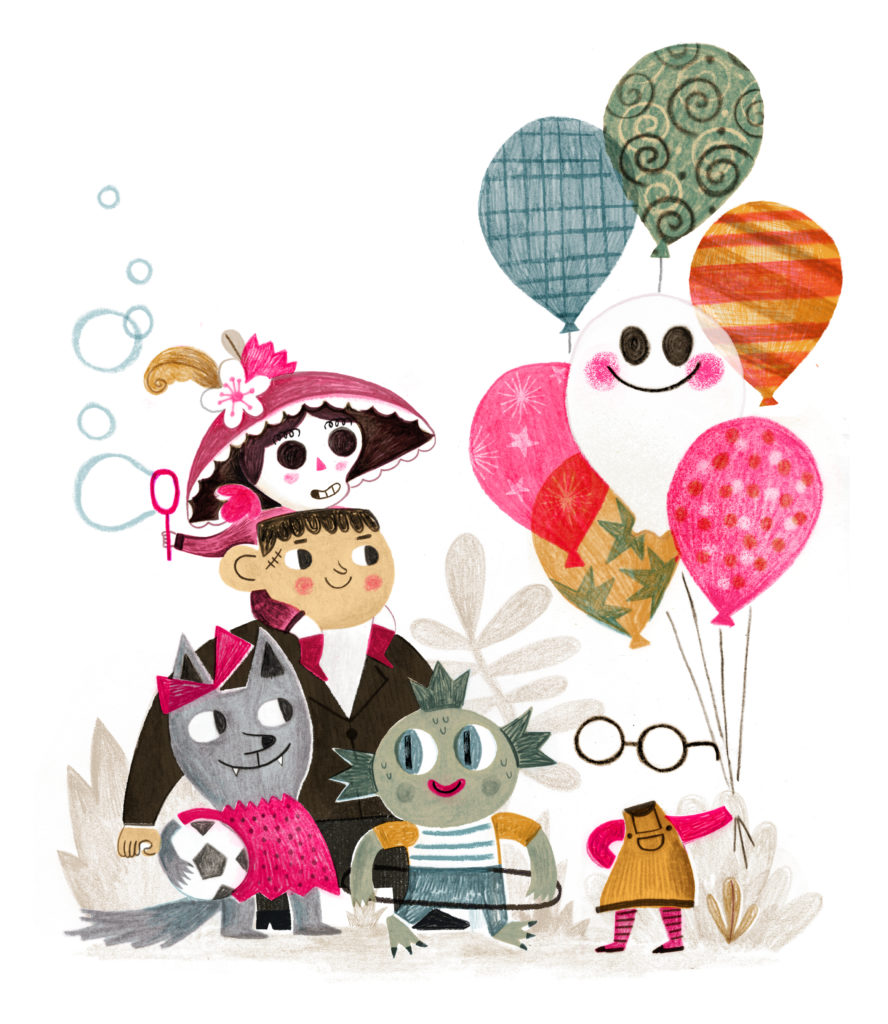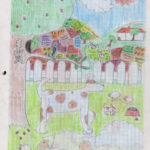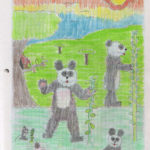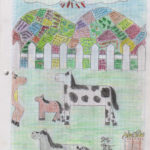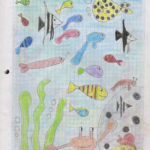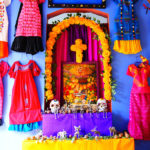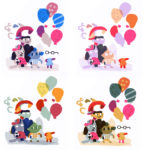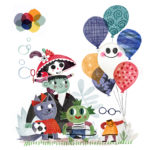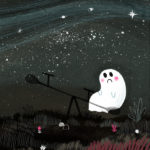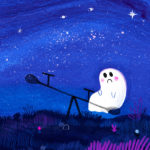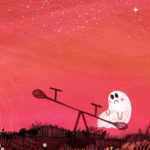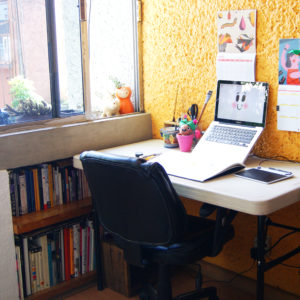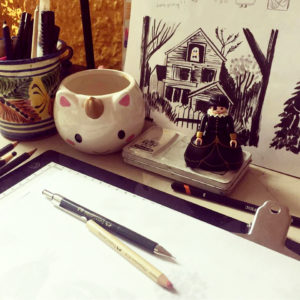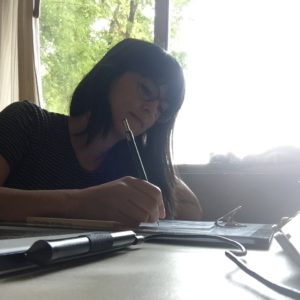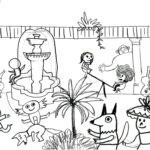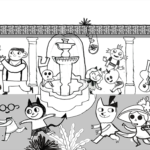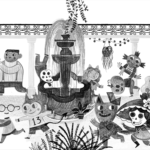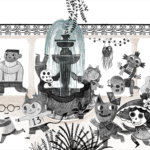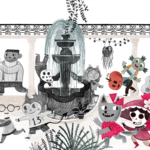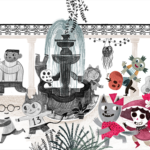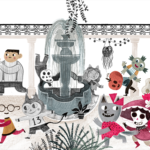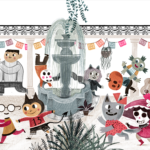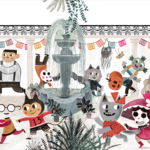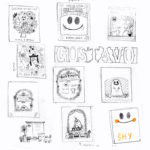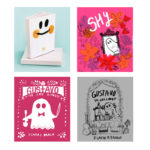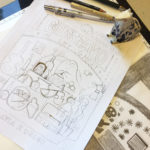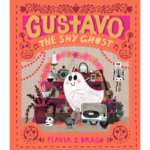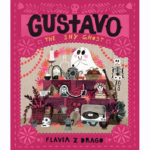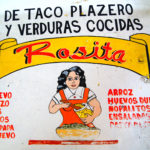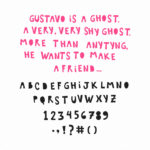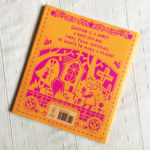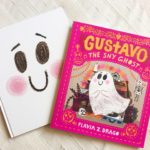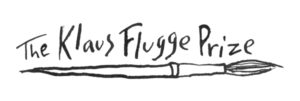
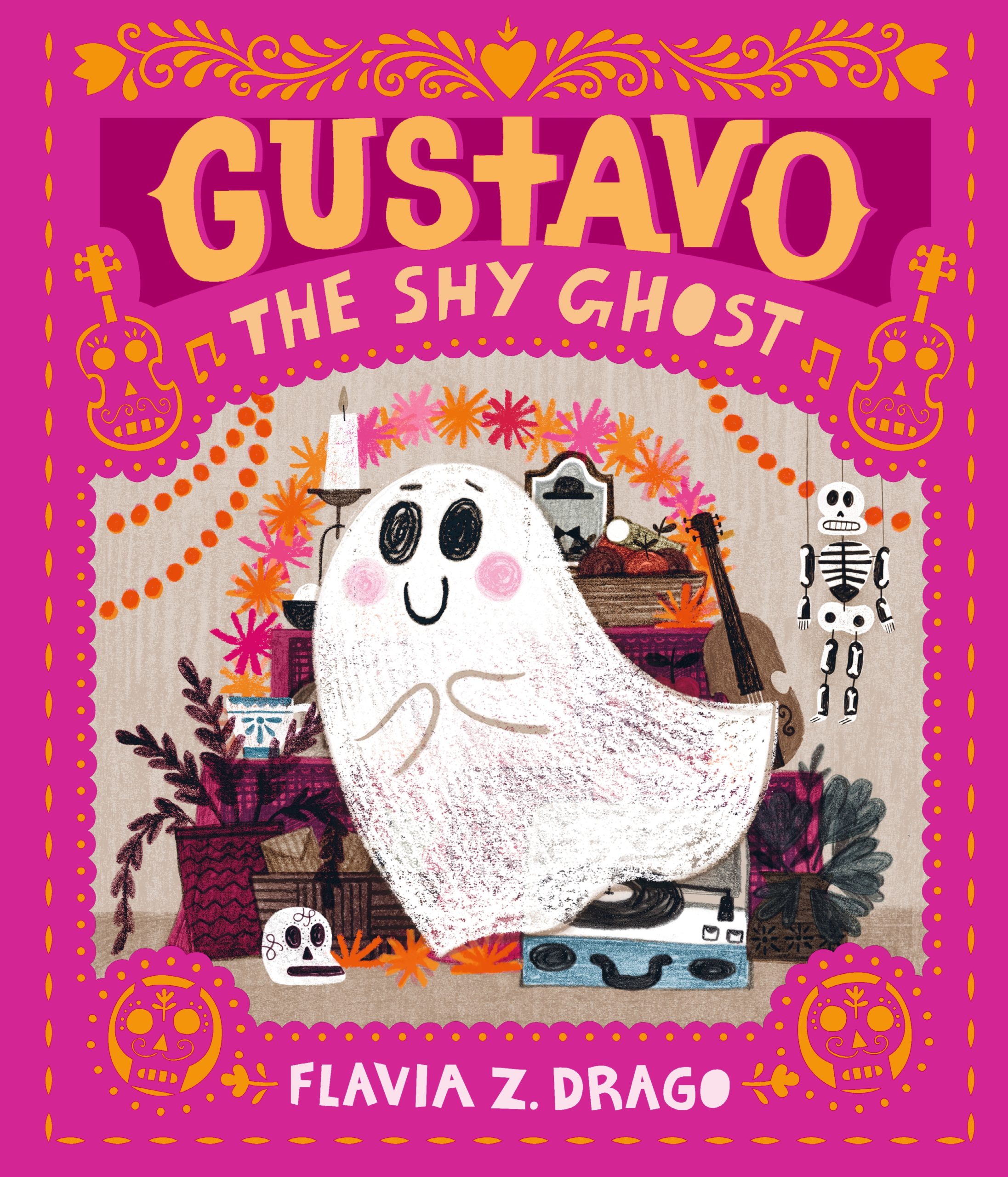
Gustavo the Shy Ghost, illustrated by Flavia Z. Drago
Gustavo the Shy Ghost, by Flavia Z. Drago, is one of the five books on the shortlist for the 2021 Klaus Flugge Prize.
The judges call her book ‘a visual treat’ and admire the way it’s full of detail but never cluttered.
Judge Mat Tobin interviewed Flavia about her book.
Mat: I loved how you tapped into that sense of shyness and reluctance to approach others that can affect children (and adults). Was the idea behind the story largely based on your own childhood and why was this an important message for you to share?
Flavia: The idea for the book came after a tweet I wrote in 2016, where I said that the reason for ghosts to wear sheets was that they are very shy. I had a little laugh and thought that it could be fun to write a book about a shy ghost, who in the end takes off his sheet and reveals his true self to others. I know that this is not how the story ends – at some point I even considered that Gustavo could be a real boy disguised as a ghost – but as the plot evolved the sheet joke became irrelevant as Gustavo was already showing his true self.
When I started making the book, I didn’t notice how much I had in common with Gustavo, but the more I got to understand him, I realised that telling this story was important for me because I wanted to show that being shy doesn’t mean that you don’t enjoy the company of people – or in this case, monsters! – It just means that you find it difficult to reach to others, especially for the first time.
Some of the things that happened to Gustavo were based on some of my own experiences. When I was in kindergarten – just like Gustavo – I sat by myself during lunch breaks, watching children play while being amazed by the fact that they seemed to be completely happy to talk and play with each other. I also remember being very nervous about having to ask for stuff in a shop, or raise my hand in class, or phoning, but even if I have gotten better, big parties still make me nervous.
The main difference between Gustavo and me, is that, sadly I cannot do the ghostly things like walking through walls, making objects fly, glowing in the dark or playing the violin. However, drawing became for me a way in which I could connect with others. In a sense our love for art has been the thing helping us both to connect with others.
Mat: I got the feeling, when reading through the book, that the whole cast of Gustavo had a special place in both the story and in your heart. Can you share with us a little about them, from their initial concepts to their completed design and, perhaps, a little of their origins? Are they acknowledging your Mexican heritage/culture or films you grew up with?
Flavia: This is exactly what happened! at some point during the process, I decided that Gustavo was going to be a ghost, which made me very happy because that meant that he could shapeshift into objects, something that could be visually playful; but also, it meant that I could create a world where Mexican calacas (skeletons) and monsters could happily live together, which meant that I could introduce children to Mexican, and horror cinema culture at the same time!
Some of my favourite characters in the book are Katerina the ‘Catrina’, the elegant skull girl in pink, based upon an engraving by Guadalupe Posada; Alma, the invisible girl who happens to be the prettiest monster in town; and the witch – with a secret name that I cannot reveal yet – who will feature as the main character on my next picture book!
Mat: With this in mind, another thing that I adored about the book was the celebration of the Day of the Dead. Throughout the whole story, there was an authentic sense of someone knowing and celebrating Mexican culture and the vernacular. Can you tell us a little bit about this?
Flavia: The Day of the Dead is my favourite Mexican tradition, because we remember our loved ones who died by making altars – that we call ofrendas – with their favourite things and food. The main idea is to celebrate their lives by welcoming them back home. As a fun fact, in the graveyard scenes, you can find the names of my late grandparents engraved in the tombstones – Chuta, Lupe, Rolando and Tuto. In a way, my book is honouring the tradition, and my loved ones at the same time.
When I was a child, I remember that some people didn’t like the idea of mixing Day of the Dead and Halloween, however, I have to say that I loved and cherished them both because they mean different things. About Halloween, I loved that I could wear silly make up, hang out with my cousins, and get sweets. Day of the Dead was a completely different feeling because I guess that there is something comforting about the thought of being remembered after you died by your loved ones.
Mat: There is so much going on in some of the spreads: Gustavo’s opening introduction; the monster-children playing around the fountain; and the celebration at the end. Yet the pages never feel overcrowded or overly busy. How did you manage this balance and did you have to make any adjustments to make it work?
Flavia: Hmmm, this is an interesting question… I am a fan of Bosch and Pieter Brueghel who are known by painting incredibly detailed scene, but also some Mexican folk art tends to have lots of details and colour, I guess I must have picked up something from them!
I don’t really know how I managed to keep the images crowded and tidy at the same time. I can tell you that making drawings with lots of details has been something that I love doing because those details help me to build a more convincing and unique world. When I was around 8 or 9 years old, I filled a whole notebook with animal drawings (see images). Such drawings contained mini scenes which added little stories to the main one, so I guess that lots of years of practice have helped me to understand how the eyes flow through the page and how I can use composition, colour, heads, and arms to point the direction where the eyes should (ideally) wander through the page.
Mat: The balance and blend of colours throughout the pages are wonderful. Can you talk us through some of the choices that you made and why? Are there some colour blends on spreads that you are particularly happy with?
Flavia: Learning how to use colour has been a slow process, I remember that on my first illustrations I tended to use all the colours of the rainbow and all the textures at the same time – what a nightmare! As I slowly learned, I realised that you can do wonders with a limited palette because it gives coherence to the illustrations, creates atmospheres, catches the eye, and also, colour conveys meaning, so it’s one of the most valuable tools to master.
When I was planning my colour palette, I went through some failures. The first blend I tried was too limited; the second one was too colourful and there was nothing really magical about it, so I had to stop for a while and think about the world I had just created. In one hand we had the black and white Universal Monsters tribute and a nostalgic ghost, which made me think of vintage pictures in sepia tones; on the other hand, we have the really bright Mexican colours. I did another experiment trying to mix both worlds and it turned out that the muted tones worked very well with the bright pink and orange. I hit the Goldilocks zone of colour.
Mat: Can I be cheeky and ask for a tour of your workspace. It’d be great to see some of the materials that you work with or spaces that are important to you.
Flavia: I just moved from Mexico to the UK to do a PhD, I have been living on my current address only for a few months so I am afraid that it still needs decoration, but here are pictures of my studio in Mexico City.
Mat: Is there a spread that you particularly loved putting together? Could you talk us through your process of this spread from concept to completion?
Flavia: My favourite spread is the one where Gustavo is looking at the monsters playing because it really reminds me of my childhood experiences. This happened to be one of the first finished spreads.
I started with a basic sketch, that later on was scanned and perfected on the computer.
Then, I did the black and white layers with pencil, ink, crayons and colours on paper.
Finally, I added the colours on Photoshop, played a bit with the composition, and refined the last details.
Mat: The design of the whole book, from the cover to the endpapers and everything in between is a delight. Can you share with us a little about the collaborative work with the designers and editor at Walker and what this entailed?
Flavia: Designing the cover was a very enjoyable process. My first idea was to have Gustavo’s face on the cover –as if he had shape-shifted into the book– but my publishers felt that even if it was a fun idea, the cover wouldn’t reflect the detailed world inside the book, so we explored different options and arrangements.
The final cover mimicked papel picado with Gustavo in front of an ofrenda. In Mexico we have a widespread tradition of hand lettering, you can see it everywhere, so I designed and traced the letters because I wanted them to have the same aesthetics as the drawings.
By the way, Candlewick Press (English) edition features Gustavo hiding in the shape of a book under the dust jacket.
Mat: Can we look forward to more picturebooks from you? Would you like to work on something alone and what are your thoughts on collaborating?
Flavia: At the moment I am doing a PhD on horror tropes and picture books in Anglia Ruskin University, so hopefully some new exciting ideas will come from my research.
I have a few new books coming up with Walker Books. This October, my monster board book collection called Monsters Play will feature familiar and new faces. On 2022 you will be able to see my second picture book with Walker Books about a family of witches who are experts in the dark arts of patisserie. It will be expanding on Gustavo’s Universe.
I would love to do some collaborations, or to illustrate someone else’s text, however at the moment my hands are quite full with all my PhD reading and experimentation. I guess I need more arms, longer days, or both!
Mat: Are there are any contemporary artists/illustrators whose work you admire so much that you think everyone should encounter them?
Flavia: There are many illustrators who I love! From Mexico my favourite illustrators are Erika Meza, Estelí Meza (they are not related), Juan Palomino, Jimena Estibaliz, Pam Medina and Sofia Weidner.
From around the world, I really love the work of Isol, Sara Fanelli, Carson Ellis, Jon Klassen, Marta Altés, Anushka Allepuz and Beatrice Alemagna - the list is endless!
Gustavo the Shy Ghost is published by Walker Books, 978-1406398502, £7.99 pbk.
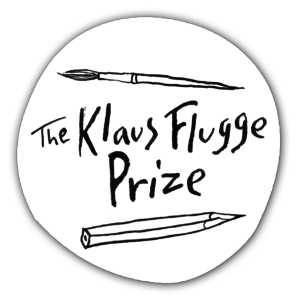
The Klaus Flugge Prize is funded personally by Klaus Flugge and run independently of Andersen Press.
Website maintenance & Copyright © 2023 Andersen Press. All Rights Reserved. Privacy & Cookie Policy.
